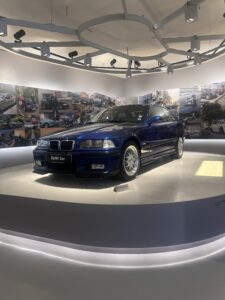Visiting the BMW Museum in Munich: A Car Person’s Dream Come to Life
When I was in Munich, I knew I had to make the pilgrimage to the BMW Museum. As a full-on car person, it wasn’t just something on the to-do list, it was a top priority. BMW has always represented a particular kind of engineering precision and design clarity to me. Seeing that legacy up close, in the city where it all began, felt like walking through the pages of a personal history book.
The museum sits right next to the BMW headquarters and BMW Welt, across from Olympiapark. You can’t miss it. The building itself is a masterpiece, this futuristic, silver bowl that looks like it’s hovering beside the iconic four-cylinder BMW tower. Designed by Karl Schwanzer in 1973, it’s the kind of structure that feels intentional down to the last detail. Even before I walked in, I was already impressed.
Once inside, it hit me how much this place is built for people who get cars. Not just to look at them, but to understand the philosophy behind them. The layout guides you chronologically through BMW’s evolution, from aircraft engines to motorcycles to the machines that made the company iconic.
The early prototypes and heritage models had me completely locked in. You don’t just see the 3 Series and M cars, you see what came before them, what influenced their lines, their engineering, their role in automotive culture. There’s a moment when you turn a corner and come face to face with the E36 M3 in Estoril Blue. It’s immaculate, refinished to perfection. Standing in front of that car, I had that “this is the one” moment. It’s a car you read about and maybe see in pictures, but here it was in front of me, and it stopped me cold.

And then the motorsport section. For someone who lives and breathes performance, this part was next-level. M cars, Formula cars, touring cars, all laid out like a timeline of speed and intent. The E30 M3, arguably one of the most important cars in performance history, was front and center. Every detail looked museum-grade but still felt alive, like it belonged on a track instead of behind a rope.
There’s also a whole floor of concept cars, many of which never made it to production, but each showed a clear line of thinking. Aerodynamics, lightweight materials, drive systems, BMW’s future-thinking design DNA was everywhere. The Vision M NEXT concept stood out in particular. Seeing it up close gave me a new appreciation for how BMW balances raw performance with sustainability.
But the museum isn’t all polish and power. There’s also the “Place of Remembrance,” a quiet room that deals directly with BMW’s use of forced labor during World War II. It’s not hidden or glossed over. The museum confronts it directly, with names, stories, and records. It gave the entire place a deeper weight, acknowledging that even a company built on innovation and performance has a complicated past.
I spent hours there and could’ve easily spent more. I wasn’t just impressed, I was in awe. It’s one thing to know the spec sheets, the Nürburgring lap times, and the production years. It’s another to see the evolution, the intention, and the engineering culture up close.
For any car person, especially one who respects BMW’s legacy, this museum isn’t just worth visiting, it’s essential. It’s not about marketing or nostalgia. It’s about seeing the actual machines and ideas that shaped an entire corner of automotive history. And if you love cars, there’s no better feeling than seeing them treated like art and engineering milestones at the same time.
Josh H
References:
BMW Museum. (n.d.). BMW Museum. Retrieved from https://www.bmw-welt.com/en/locations/museum.html
Munich Travel. (n.d.). BMW Museum in Munich: Essential Information. Retrieved from https://www.munich.travel/en/pois/arts-culture/bmw-museum
